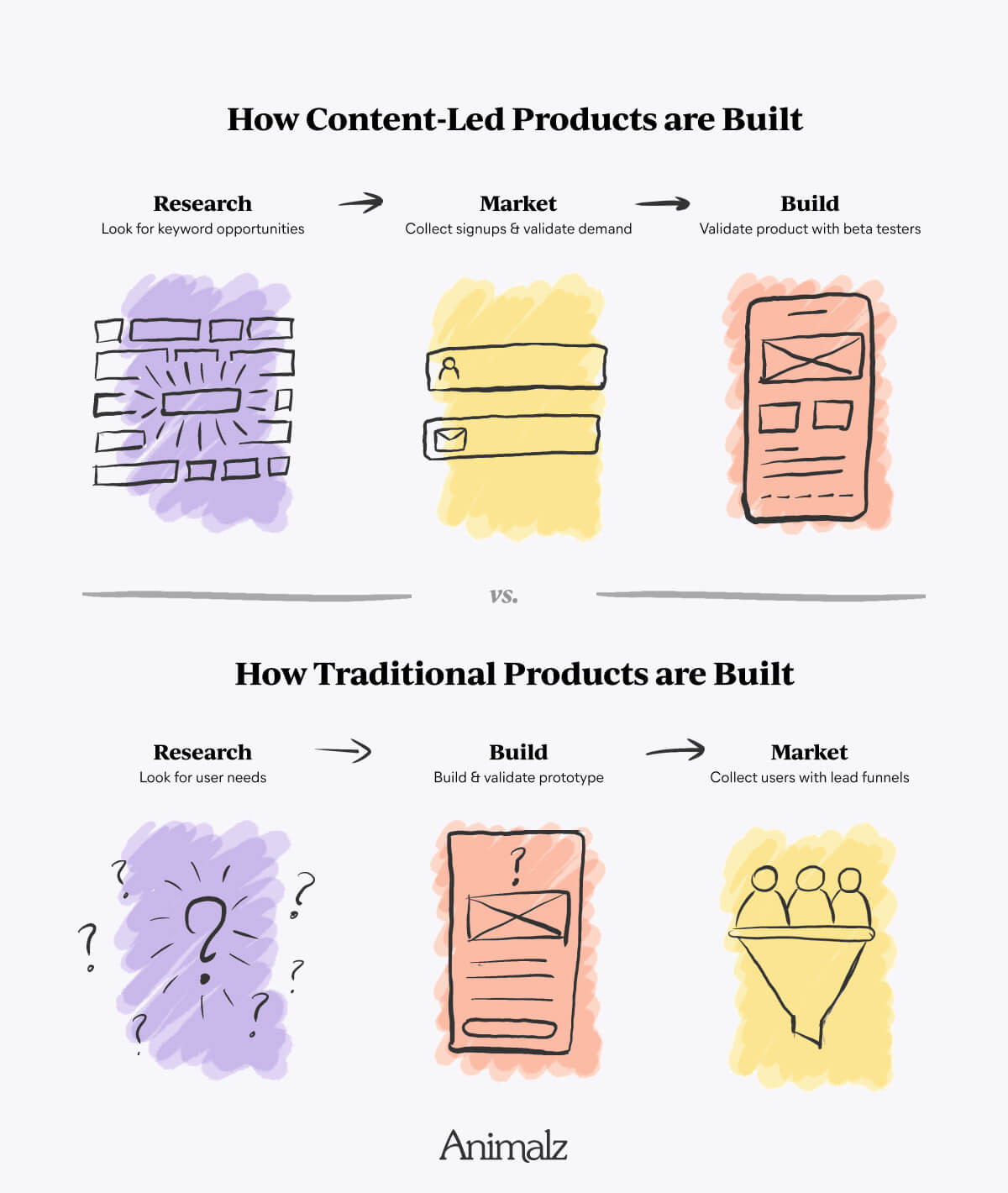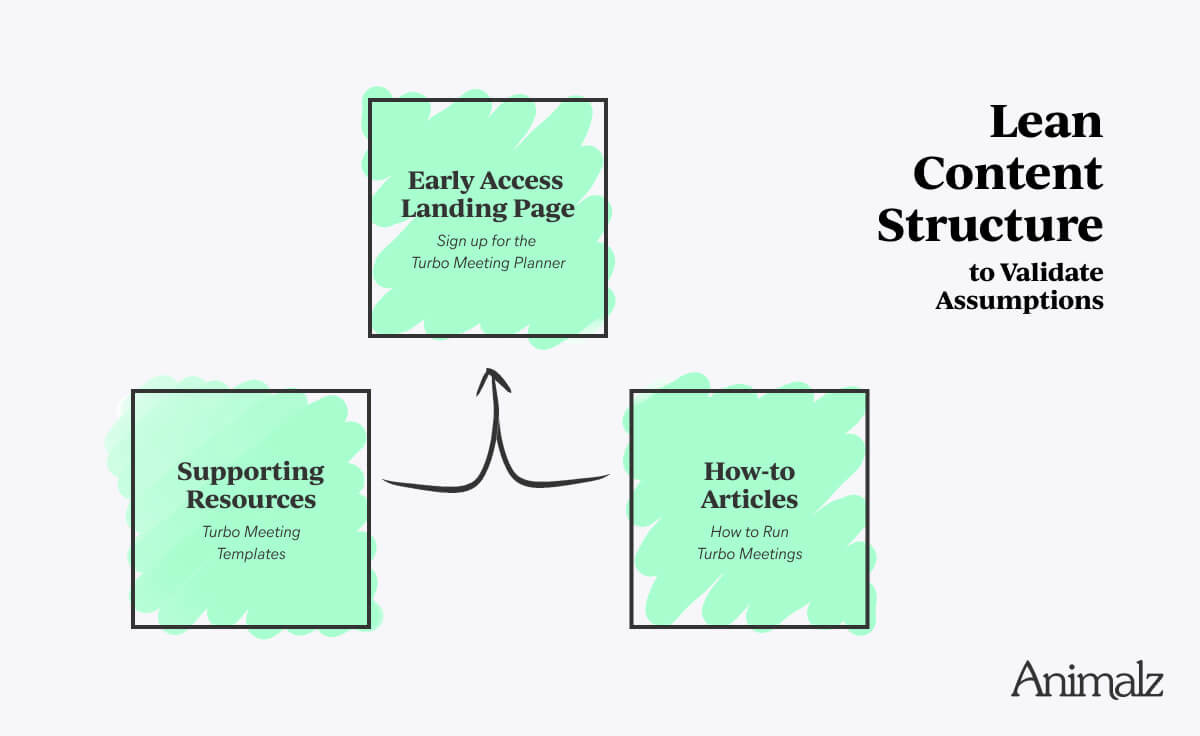Gareth Davies is the content lead at Parabol, an online Agile meeting tool. He explains how they’ve pioneered a unique approach to product development called “content-led product.”
As a content marketer, you might think your job is crafting stories to attract customers to your product. But your skills, insights, and strategic perspective could shape the very core of your business by influencing what your product team builds next.
Traditionally, product teams build first and then bring in marketers. With “content-led product,” you reverse this process by starting with content and then using it to inform product development.
What Is Content-Led Product?
Content-led product is an approach we’ve pioneered at our startup Parabol, in which teams use content to validate new markets and product ideas. The SEO results and reader interest in a topic inform what we build next.
This practice is inspired by but not to be confused with product-led content – the idea that content should always mention your product in a relevant way, directly benefit the reader, and help solve their questions.

There’s a well-known mantra in product circles: “If you build it, they will come.” But if nobody finds your product in a saturated market, how will they come to you? Content-led product challenges this wisdom and says, “If they come to us, we will build it.”
For example, if you notice a surge in readership for articles about “remote work tools,” it might be a signal to develop a product in that space.
Content Is the Leanest Product
Without building anything, content-led product helps you validate ideas and organic traffic potential. That’s a big deal for SaaS companies where product building is expensive, marketing is often an afterthought, and survival depends on getting new users through the door as quickly as possible.
There are a few reasons why content is the leanest way to begin product exploration:
Content is faster to create than product: Content is the leanest MVP for validating organic interest in a potential product or a new feature. Making a few pieces of content on your target topic takes weeks rather than months – whether that’s top-of-funnel SEO content, email, or even social posts. It’s a faster and cheaper way to get feedback on an idea than building prototypes (or worse, complete products).
Creating content helps verify if you can rank: Ranking is notoriously hard for new SaaS companies now that SEO is a mature practice. Investing in content first helps verify if there is an organic traffic stream you can tap into to market your new product or feature.
Investing early in content gives it the time needed to rank: When you create content at the start of the product development process, you give Google time to shuffle the deck and index your content. (If you’re worried that it takes time for content to rank, you can promote it with ads and use early access sign-ups as an indicator of interest.)
Content helps grow an audience in advance. When you create content before – or in parallel with – product development, you’re building an audience for your idea in advance. Once the product is ready, the audience is already coming to you.
Content is easier to discard. The cost of pivoting is lower if you’ve only built some content. When teams have spent developer and designer hours building a prototype, it’s much harder to justify pivoting.
How Does Content-Led Product Work in Practice?
Our content-led product experiment began with a question posed to the whole company: “What should we build next?” Instead of making a wild guess or only speaking to existing users, we started digging into SEO research tools, looking at factors like keyword volume, keyword difficulty, relevance, search intent, and social mentions.
We looked for keyword opportunities that could validate whether there was an audience for our new product ideas. In our case, that meant ranking various meeting and activity types.
A Framework To Focus on the Content That Helps You Learn the Most
When validating product ideas, you want to focus on creating content in which you’ll learn the most from readers – winning traffic to a “how to” article generally indicates a problem to be solved.

For each of the product areas we chose to validate – in our case, “post-mortem” and “pre-mortem” meetings – we created a lean content pyramid with three types of content. You can borrow this model to validate your own new product experiences.
1. Create content for people searching for a tool
We created landing pages for our post-mortem and pre-mortem experiences to collect early access sign-ups. These pages also served as bottom-of-the-funnel destinations for other content.
Creating such product pages helped us understand whether people were searching for “post-mortem tools” or “pre-mortem tools” and how many would convert to early access requests.
This approach allowed us to collect many early access users who would be the first to test the new product, allowing us to recruit beta testers if we decided to build the product.
2. Create content for problem-aware readers
How-to “recipe” content is the bread and butter of SEO because it speaks directly to people who are problem-aware. They’ve got a pain and hope your content will solve it.
Creating content for problem-aware readers is an excellent way to validate your idea. We made articles on “how to run a post-mortem” and “how to run a pre-mortem” that framed our product idea as a solution.
We collected early access sign-ups from these pieces of content and signals that people were interested in our product to solve their problems.
3. Create supporting content
Supporting content sits high in the funnel and helps validate your product idea in several ways:
Topic resonance: Discover which topics interest your audience. For example, if you’re developing a project management tool and find that “Agile methodologies” receives higher engagement than “Waterfall methodologies,” you’ve learned something about your customers’ interests.
Ranking signal: High-performing supporting content can help pass ranking signals to articles lower in the funnel, improving their visibility.
Topical authority: Ranking for various topics within your niche establishes your brand as an authority, making it easier to introduce a new product to a receptive audience later.
We also used template pages to win traffic for product ideas. While people may not have been searching for a whole tool to run a post-mortem meeting, they may be searching for a template. Templates serve as a quick solution that directly addresses their problem, validating your product ideas and offering multiple entry points to any future product.
Overcoming Obstacles to Content-Led Product
Bridging the gap between marketing and product teams is one of the main challenges of adopting a content-led product approach. Convincing your CEO, head of marketing, or a product manager that content can inform product development isn’t easy.
Here are some compelling arguments to help persuade others to give content-led product a shot:
Leverage unique market insights: Content marketers bring new customer insights into the product development process, enriching the team’s perspective and leading to more user-centric products.
Improve cross-functional collaboration: Content-led product development brings product and marketing teams closer, breaking down silos and leading to more inclusive and innovative solutions.
Validate ideas faster: A content-led approach allows for quicker and cheaper validation of product ideas, saving both time and resources.
Build a pre-launch audience: Content can create a ready audience for a product before it’s even launched, reducing the time and effort needed to gain initial traction.
Experiment without risk: Trying out content-led product is a relatively small experiment. Frame it as such so it’s easier for stakeholders to approve. If the approach doesn’t work, you can discontinue it without significant repercussions.
Align product and marketing goals: Content-led product development ensures that marketing and product teams align on a new feature or product from its inception, making subsequent promotional efforts more effective.
Getting Started With Content-Led Product
With content-led product – as with many things at work – it’s easier to ask for forgiveness than permission. If you think this approach could help your company exploit gaps in the market or de-risk new product ideas, then why not just start doing it?
The simplest way to start or consider your options is to form new connections with other teams. Take an interest in the work of your product team or designers and surface market insights as you come across them. Schedule 1:1 meetings to get to know people better. Express content-led product as something you want to try and gauge the response. See if you can join product planning sessions to see how they work. There are numerous low-stakes ways you can better understand the terrain in your organization to propose an experiment with content-led product development.
By turning the traditional product development process on its head, we put marketing and the content marketing skillset in their rightful places – vital components in creating more innovative and inclusive products.
If you found Gareth’s framework for content-led product development insightful, you might also enjoy our guest post from Mark Rogers, Director of Content Marketing at Freshpaint. Mark shares his approach to idea-centric content marketing and how it has helped them drive industry conversations and establish thought leadership.
Want to develop a unique and effective content strategy like Parabol?We help companies grow through innovative content approaches.Let’s talk content!
